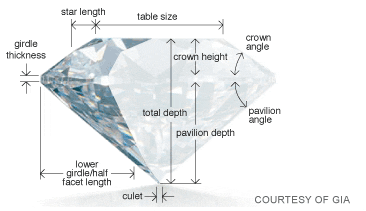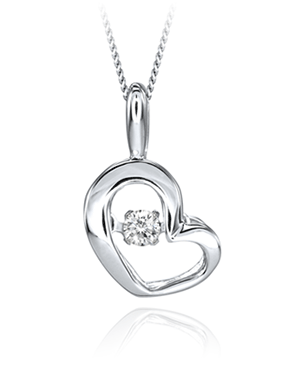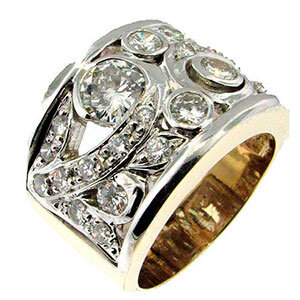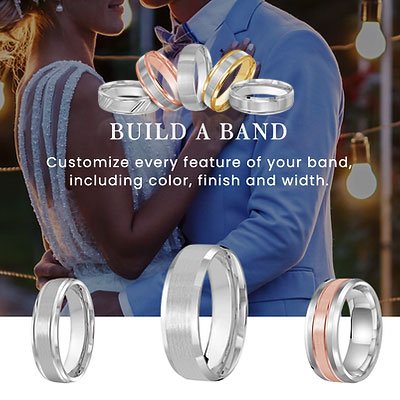A natural Diamond forms under high temperature and pressure conditions that exist only about 100 miles beneath the earth’s surface. Diamond’s carbon atoms are bonded in essentially the same way in all directions. Another mineral, graphite, also contains only carbon, but its formation process and crystal structure are very different. Graphite is so soft that you can write with it, while diamond is so hard that you can only scratch it with another diamond.
Diamonds are among nature’s most precious and beautiful creations.
Learn more about the 4 C'S below↴
The term "cut" has two references: one is the diamond's shape, the other is the quality, determined by its proportions, symmetry and polish.
The top-selling diamond cut shape is the round brilliant. Other cut shapes including princess, marquise, pear, heart, oval, emerald, radiant, cushion and asscher are considered fancy cut.
The cut of a diamond is considered to be the most important factor with respect to its beauty.
The cut determines the brilliance of the diamonds - how light is reflected, dispersed and scintillated. Unlike colour and clarity, there is not a single grade that defines it.
Two diamonds equal in carat weight, colour and clarity can differ in appearance and value because of differences in cut quality.
The cut is the most complicated of the 4Cs. Unlike carat weight, colour and clarity, whose value and rarity are related to the diamond's natural formation, cut quality is the result of human decision and diamond cutting skills.
Diamonds and other gemstones are weighed in metric carats: one carat is equal to 0.2 grams, about the same weight as a paperclip. (Don’t confuse carat with karat, as in “18K gold,” which refers to gold purity.)
Just as a dollar is divided into 100 pennies, a carat is divided into 100 points. For example, a 50-point diamond weighs 0.50 carats.
But two diamonds of equal weight can have very different values depending on the other members of the Four C’s: clarity, color and cut.
The majority of diamonds used in fine jewelry weigh one carat or less.
Because even a fraction of a carat can make a considerable difference in cost, precision is crucial. In the diamond industry, weight is often measured to the hundred thousandths of a carat, and rounded to a hundredth of a carat.
Diamond weights greater than one carat are expressed in carats and decimals. (For instance, a 1.08 ct. stone would be described as “one point oh eight carats,” or “one oh eight.”)
Choosing the right colour for your diamond is based on personal preference. It's important to remember that you are generally searching for a stone with little to no colour. Diamonds are coloured when the crystals grow inside the earth.
Tiny traces of some elements like nitrogen can colour the crystals.
In addition, the pressure involved in the diamond formation creates distortion in the crystal structure which is believed to also contribute to its colour.
The colour evaluation on gem-quality diamonds is based on the absence of colour. The Gemological Institute of America (GIA) uses a 12-letter alphabetical scale of D to Z.
Using this scale, the diamond on the lower end of the scale (D) will have the least amount of colour - it is considered a colorless stone. The diamond at the higher end of the scale (Z) has deeper tones. However, when a diamond's colour is more intense than the "Z" grading, it enters the realm of a "Fancy Colour" diamond.
In this case, the intensity of the colour in the diamond can play a significant role in its value.
The value of a Fancy Colored Diamond can surpass that of colorless diamonds if the intensity of the colour is high and the colour is rare.
D grade is absolutely colourless E and F are essentially colourless.
The difference between D, E, and F is so slight that only experts can see it when the diamonds are unmounted.
K, L, and M are faintly tinted. Diamonds under 1/2 carat appear colourless when mounted. Diamonds over 1/2 carat may show a tint of colour.
Grades N through Z have a light tint, and it is visible. Diamonds with less colour are more rare and valuable. Only about 5,000 of the polished diamonds produced each year weighing 1/2 carat or more are colourless.
Most of the diamonds sold are grades G to L. For fancy diamonds, the value goes up with the intensity of the colour.
Fancy colours include bright yellow, pink, champagne, blue and green. Red, purple and orange diamonds, though found in nature, are extremely rare.
How the diamond is set can make a difference in colour too.
Colour is more important in rings than earrings and pendants because the diamond is usually larger.
Putting a truly colourless diamond in a yellow gold setting will reflect on the stone causing a yellowish tint.
Colourless and near-colourless diamonds come alive in a platinum or white gold setting.
A slightly yellow-tinted diamond will appear whiter in a yellow gold setting. Keep in mind that colour is only one of the 4Cs so even when a stone has a visible tint, it can still be very lovely when mixed with good clarity and cut.
The term FL or flawless is used for diamonds in which a qualified observer, under favorable lighting conditions, cannot find internal characteristics and/or faults by thorough examination with a 10X loupe. The IF Grade (Internally Flawless)
A diamond which has no internal characteristics but which, due to minor finish faults, is not flawless and therefore cannot be designated FL or flawless, may be called IF or internally flawless provided the finish faults are so minute that they can be removed by a gentle polishing with only an insignificant loss of weight. The VVS Grades (Very, Very Small Inclusions).
The term VVS is used for diamonds with internal characteristics very, very difficult for a qualified observer to find under observation conditions as described. Further, there may only be insignificant finish faults. The VS Grades (Very Small Inclusions)
The term VS is used for diamonds in which it is difficult for a qualified observer, under observation conditions as described, to find either a few somewhat larger internal characteristics or several very small ones.
The SI Grades (Small Inclusions). The term SI is used for diamonds in which a qualified observer may, without difficulty, under observation conditions as described, find internal characteristics. Further, there may only occur single finish faults of an insignificant kind.
The I Grades (Imperfect).The term I or imperfect is used for diamonds in which a qualified observer, with the naked eye, can see internal characteristics and/or in which such major faults occur, which substantially reduce the value of the stone.
Only about 2% of the world's diamonds are actually flawless. Most retail stores carry VVS as their highest grade. VS or SI are considered by most to be "fine quality" diamonds.
TYPES OF DIAMOND FLAWS
Diamonds often possess unique markings – either internal (known as inclusions) or external (known as blemishes).
A diamond's clarity grade depends on the absence or abundance of such inclusions and blemishes.






























